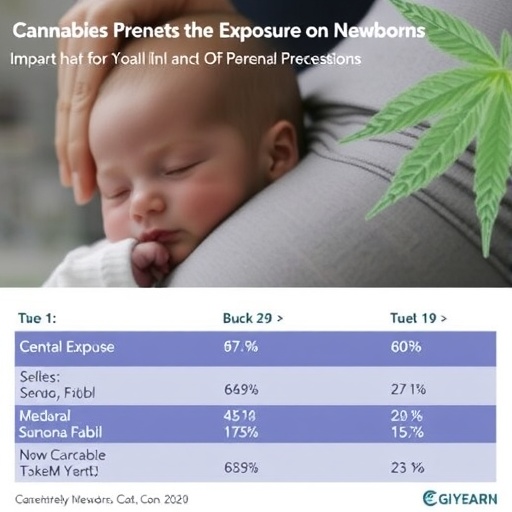
The Rising Tide of Prenatal Cannabis Exposure: Unraveling the Neurodevelopmental Consequences Amidst Escalating Potency and Social Acceptance
In recent years, the landscape of cannabis use has transformed dramatically, fueled both by shifting societal norms and expanding perceptions of its therapeutic value. Among the most vulnerable populations increasingly exposed to this trend are pregnant women, with a noticeable rise in cannabis consumption during pregnancy documented globally. This phenomenon is particularly concerning given the concurrent escalation in the psychoactive potency of cannabis products, which now contain tetrahydrocannabinol (THC) concentrations soaring from historically low averages of 5% to alarming levels around 30%. This convergence of increased usage and higher THC concentration underscores an urgent call to scrutinize the implications of prenatal cannabis exposure on neonatal and infant health.
Understanding the biochemical and physiological underpinnings of THC’s impact on fetal development is paramount. THC readily crosses the placental barrier, traversing from maternal circulation into the fetal environment, where it can interfere with the fetal endocannabinoid system—an intrinsic signaling network pivotal for brain development and synaptic formation. Unlike most transient maternal substances, THC has the propensity to accumulate within fetal tissues, a process that might potentiate long-term neurodevelopmental disturbances. Furthermore, THC permeates breast milk, resulting in neonatal ingestion postnatally; breastfed infants are estimated to receive approximately 2.5% of the maternal THC dose, compounding concerns about sustained neurodevelopmental disruption during critical growth windows.
.adsslot_OJ8eVGorQb{width:728px !important;height:90px !important;}
@media(max-width:1199px){ .adsslot_OJ8eVGorQb{width:468px !important;height:60px !important;}
}
@media(max-width:767px){ .adsslot_OJ8eVGorQb{width:320px !important;height:50px !important;}
}
ADVERTISEMENT
Epidemiological data have increasingly linked prenatal cannabis use with several adverse perinatal outcomes. Studies aggregating data have shown correlations between in-utero exposure and lower birth weights, heightened risks of preterm labor, increased admissions to neonatal intensive care units, and diminished Apgar scores at birth. These markers suggest that the fetus exposed to maternal cannabis is vulnerable not only to immediate health challenges postpartum but also to subtle and insidious developmental impairments that may manifest later in life.
Decades-long longitudinal research sheds further light on the neurological sequelae of prenatal cannabis exposure, revealing alterations in brain structure and function among affected offspring. Advanced neuroimaging techniques indicate variances in regions implicated in memory consolidation, attentional processing, and executive function—cognitive domains central to academic performance and social integration. These neural discrepancies often translate to measurable deficits in learning capacity, impulse control, and working memory, raising red flags about the potential lifelong ramifications on cognitive and behavioral health.
The ethical constraints surrounding the deliberate administration of cannabis in controlled clinical trials involving pregnant women impose significant limitations on definitive causal inference. As such, the current knowledge base predominantly rests on observational studies and meta-analyses that, while robust, cannot eliminate confounding factors totally. This research gap underscores the critical need for meticulously designed longitudinal studies capable of teasing apart the complex interplay of cannabis exposure, genetics, socioeconomic factors, and concurrent substance use to better define causality and risk stratification.
The neuropharmacology of THC offers insight into its disruptive potential. The endocannabinoid system, encompassing cannabinoid receptors CB1 and CB2, along with endogenous cannabinoids, orchestrates neurogenesis, neuronal migration, and synaptic pruning during fetal development. Exogenous THC’s affinity for CB1 receptors in the fetal brain perturbs this tightly regulated process, leading to aberrant wiring and neurochemical imbalances. These molecular interferences may underlie the structural and functional brain abnormalities observed in exposed neonates and children.
Compounding this concern is the reality of modern cannabis cultivation and product formulation, with strains engineered for maximum THC potency. Consumers, including pregnant women, are potentially exposed to doses of THC that differ vastly from those in past decades, amplifying the risk profile. The synergistic presence of other cannabinoids and compounds in cannabis further complicates predictions of fetal impact, as the ‘entourage effect’ may modulate the overall pharmacodynamics and toxicity.
Beyond immediate birth outcomes and cognitive deficits, there is mounting evidence hinting at behavioral disturbances and psychiatric vulnerability in offspring prenatally exposed to cannabis. Disorders such as attention deficit hyperactivity disorder (ADHD), anxiety, and depressive symptoms have been reported at higher rates in these populations. While causality remains to be conclusively established, these associations warrant heightened clinical vigilance and public health intervention.
The pervasiveness of cannabis during pregnancy also poses significant challenges to healthcare providers. Screening protocols, counseling strategies, and harm reduction approaches are still evolving. Consistent, evidence-based guidelines are urgently needed to aid obstetricians, pediatricians, and mental health professionals in addressing this emerging public health issue. This requires a delicate balance between respecting patient autonomy and delivering clear communication on potential risks.
In parallel, public health messaging must adapt to counteract misconceptions fueled by the widespread narrative of cannabis as a benign or beneficial substance. The often-cited notion of cannabis as a remedy for morning sickness or anxiety during pregnancy lacks robust evidence and ignores associated harms. Public education campaigns need to leverage the latest scientific findings to inform expectant mothers and caregivers, promoting informed decision-making.
From a policy perspective, legalization and increased accessibility of cannabis products demand concurrent reinforcement of frameworks to monitor usage trends in vulnerable groups, such as pregnant women. Surveillance systems and registries could provide real-time data to inform targeted interventions and help allocate resources effectively. Collaboration across sectors—including healthcare, social services, and law enforcement—is essential to create a comprehensive strategy.
Technological advances in neonatal neuroimaging and biomarker identification hold promise for early detection of cannabis-related neurodevelopmental disruptions. Implementing these diagnostic tools in clinical practice could facilitate early intervention and potentially mitigate adverse outcomes through tailored therapies and educational support.
While observational evidence accumulates, there remains an imperative to expand preclinical research using animal models and in vitro systems. These studies can illuminate mechanistic pathways and dose-response relationships unapproachable in human subjects, ultimately guiding safer therapeutic development and policy formulation.
Moreover, the implications of THC exposure extend beyond individual health, potentially influencing societal and economic domains through impacts on education, workforce participation, and healthcare burden. A comprehensive meta-analysis of these broader consequences is crucial to fully appreciate the magnitude of prenatal cannabis exposure.
As the scientific community grapples with these complex challenges, the consensus is clear: prenatal exposure to increasingly potent cannabis presents significant risks to neonatal and neurodevelopmental health. Effective strategies to curb usage during pregnancy must be grounded in rigorous research, multidisciplinary collaboration, and transparent communication to safeguard the next generation.
Subject of Research: Prenatal cannabis exposure and its effects on neonatal outcomes and neurodevelopment
Article Title: Evidence on the effect of in-utero cannabis exposure in neonates
Article References:
Thayyil, B., Yusuf, K. Evidence on the effect of in-utero cannabis exposure in neonates.
J Perinatol (2025). https://doi.org/10.1038/s41372-025-02383-1
Image Credits: AI Generated
DOI: https://doi.org/10.1038/s41372-025-02383-1
Tags: breastfeeding and cannabis exposurecannabis consumption trends among pregnant womenfetal endocannabinoid system disruptionimplications for neonatal healthlong-term effects of cannabis on newbornsmaternal cannabis use during pregnancyneurodevelopmental consequences of cannabisprenatal cannabis exposure effectsrising potency of cannabis productssocietal norms and cannabis useTHC accumulation in fetal tissuesTHC impact on fetal development





